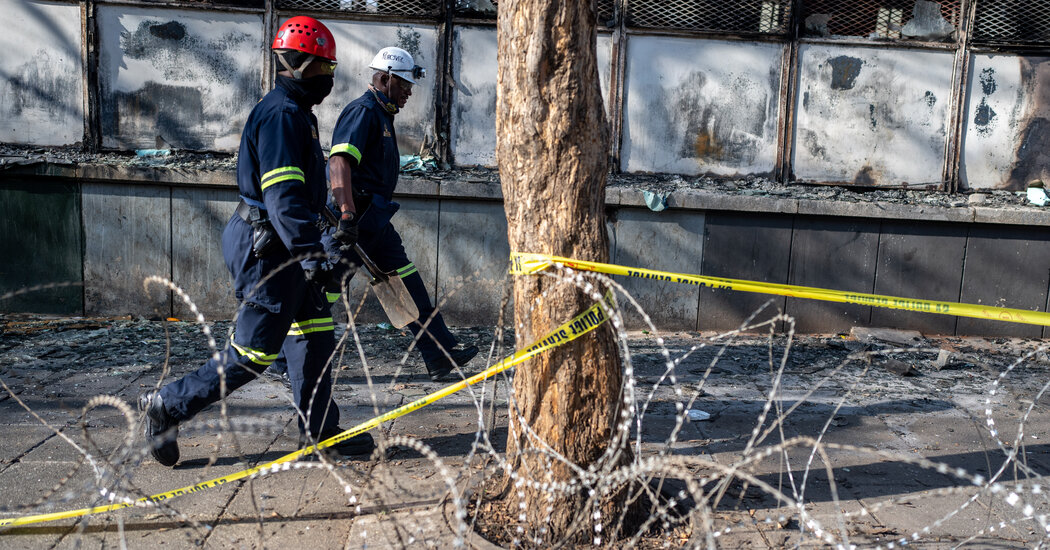Some people gathered outside a mortuary in Johannesburg on Friday, fearing the worst for missing family members. Others went to hospital after hospital, desperately searching for friends and relatives, hoping against all odds that they were safe somewhere else.
Families of the victims of a fire in Johannesburg are facing the grim struggle of trying to find out whether their relatives are alive or dead, a day after a devastating blaze tore through an overcrowded building in one of the deadliest residential fires in South African history.
The fire, which broke out in the early hours of Thursday, consumed a five-story building that was an illegal home for hundreds of families and has become a grisly symbol of official failure to address a dire housing crisis in Johannesburg. At least 74 people died in the fire, a dozen of them children, with some victims jumping to their deaths from the building and others trapped inside.
Health officials on Friday urged people to come forward to identify their relatives at a mortuary.
But answers to their questions could take days, with officials saying that 62 of the bodies recovered from the charred building were so badly burned they were beyond recognition — meaning that DNA testing would be needed to properly identify those victims.
“That means that it will delay the process of families being able to be informed properly,” Motalatale Samuel Modiba, a spokesman for the Health Department, told reporters. He added that the results of the testing could take 24 to 72 hours or longer. “We need to allow the current process of DNA to unfold.”
Health officials said that 40 men and 24 women were among the victims and that 10 of the bodies were unidentifiable. A hotline has been set up to help families trace lost relatives, and more than 60 people were treated at hospitals, they said, with injuries including burns, fractures and smoke inhalation.
Still, relatives of the victims on Friday morning said they were desperate for answers, with some saying they had received confusing information about where to go.
“All I want to see today — is to see the body,” one man who said he believed his brother had died in the fire told SABC News as he waited outside one mortuary. “I hear, yes, but I need to see. But right now we are still in the dark,” he added.
On Friday, the official search for survivors appeared to be over. Police were seen taking search dogs around the charred site and Robert Mulaudzi, a spokesman for the emergency services, said staff were conducting a final floor-by-floor sweep of the burned building for any remaining bodies. Mr. Mulaudzi said that firefighters entering the building had encountered “obstructions,” which had posed a challenge.
A faith-based organization hosted a prayer service on Friday near the site of the fire.
The focus is now turning to a search for accountability for the victims of a disaster that officials said should never have happened.
“This is the type of death that we never wish on anyone,” President Cyril Ramaphosa said on Thursday evening at the scene of the blaze. Assistance would be given to survivors who lost their homes, many of whom were in a state of shock and injury, he said.
He called the tragedy a “wake-up call,” underlining the urgency of dealing with the chronic housing situation that afflicts poor parts of Johannesburg in particular.
The city’s officials needed to find solutions to the challenge of housing in one of South Africa’s most populous cities, he said, adding that they would also root out “criminal elements” preying on vulnerable people in need. Residents of the burned building have described a system in the building in which organized groups demanded payment from them.
The cause of the blaze remained unclear on Friday and officials said they were setting up an investigation.
Preliminary evidence suggested that the fire started on the ground floor of the building, a local official said, and a security gate may have trapped many residents as they tried to flee. Some of the earliest flames, according to imagery of the fire, were spotted in the building’s courtyard but the exact origin of the blaze may take time to pinpoint.
Rights groups and residents said they have long feared such a tragedy in a city where hundreds of derelict structures are illegally occupied. Thousands of residents, including South Africans and migrants struggling to find employment and housing, live in dangerous conditions.
The buildings often do not have access to running water, electricity and working bathrooms, or safety features like fire escapes, extinguishers and sprinklers. That has prompted inhabitants to light open fires for light, cooking and warmth during cooler seasons.
Owned by the city, the building consumed by the blaze was once used for controlling the movement of Black workers during the apartheid era. In recent years, it had been leased to a nonprofit group that offered women and children emergency shelter before being abandoned. Residents said it then become a warren of subdivided dwellings in which hundreds of people had sheltered.
In October 2019, the authorities raided the building and arrested 140 people in an illegal rent scheme, said Floyd Brink, the city manager of Johannesburg, but the case was closed in 2022 for lack of evidence.


